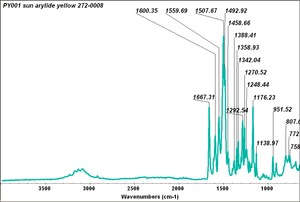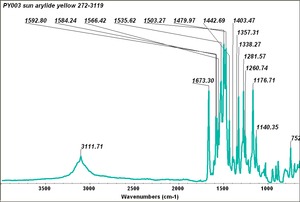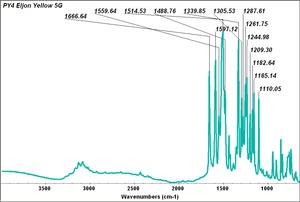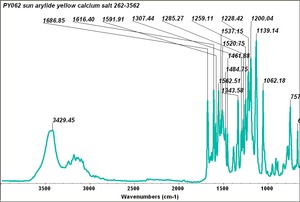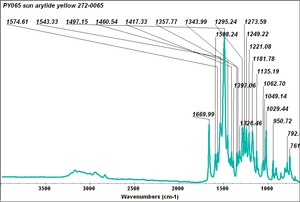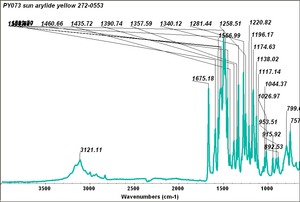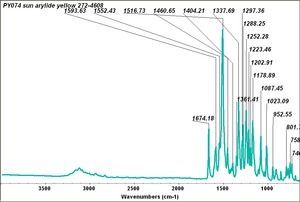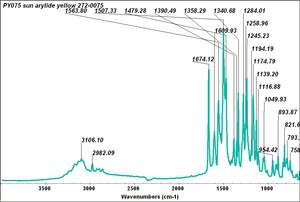Difference between revisions of "Arylide"
| (7 intermediate revisions by 2 users not shown) | |||
| Line 1: | Line 1: | ||
== Description == | == Description == | ||
| − | A class of synthetic yellow, orange and red organic colorants. These insoluble direct azo dyes were first synthesized from aniline-based diazonium salts and acetoacetarylide in 1909. Arylide was sold commercially as Hansa yellow by Hoechst AG in 1915. Arylide yellows have good tinting strength, opacity and solvent resistance. They have good lightfastness and are primarily used in printing inks, plastic, rubbers, as well as architectural and artists paints. Monoarylide yellows have better lightfastness than diarylides. | + | A class of synthetic yellow, orange and red organic colorants. These insoluble direct azo dyes were first synthesized from aniline-based diazonium salts and acetoacetarylide in 1909. Arylide was sold commercially as [[Hansa yellow]] by Hoechst AG in 1915. Arylide yellows have good tinting strength, opacity and solvent resistance. They have good lightfastness and are primarily used in printing inks, plastic, rubbers, as well as architectural and artists paints. Monoarylide yellows have better lightfastness than [[Diarylide dye|diarylides]]. |
== Synonyms and Related Terms == | == Synonyms and Related Terms == | ||
| Line 7: | Line 7: | ||
monoarylide; diarylide; azo dye; monoazo dye; Hansa yellow; colorante azoico (Esp.); colorante azoico (It.) | monoarylide; diarylide; azo dye; monoazo dye; Hansa yellow; colorante azoico (Esp.); colorante azoico (It.) | ||
| − | [[[SliderGallery rightalign|PY001 sun arylide yellow 272-0008.TIF~FTIR PY1(MFA)|PY003 sun arylide yellow 272-3119.TIF~FTIR PY3(MFA)|PY062 sun arylide yellow calcium salt 262-3562.TIF~FTIR PY62(MFA)|PY065 sun arylide yellow 272-0065.TIF~FTIR PY65(MFA)|PY073 sun arylide yellow 272-0553.TIF~FTIR PY73(MFA)|PY074 sun arylide yellow 272-4608.TIF~FTIR | + | [[[SliderGallery rightalign|PY001 sun arylide yellow 272-0008.TIF~FTIR PY1(MFA)|PY003 sun arylide yellow 272-3119.TIF~FTIR PY3(MFA)|PY4 Eljon Yellow 5G.TIF~FTIR PY4(MFA)|PY062 sun arylide yellow calcium salt 262-3562.TIF~FTIR PY62(MFA)|PY065 sun arylide yellow 272-0065.TIF~FTIR PY65(MFA)|PY073 sun arylide yellow 272-0553.TIF~FTIR PY73(MFA)|PY074 sun arylide yellow 272-4608.TIF~FTIR PY74(MFA)|PY075 sun arylide yellow 272-0075.TIF~FTIR PY75(MFA)]]] |
== Comparisons == | == Comparisons == | ||
| − | |||
{| class="wikitable" | {| class="wikitable" | ||
| Line 17: | Line 16: | ||
|- | |- | ||
| PY003 || Sun|| arylide yellow || 272-3119 || | | PY003 || Sun|| arylide yellow || 272-3119 || | ||
| + | |- | ||
| + | | PY004 || unknown|| eljon yellow 5g || unknown || | ||
|- | |- | ||
| PY062 || Sun|| arylide yellow || 262-3562 || | | PY062 || Sun|| arylide yellow || 262-3562 || | ||
|- | |- | ||
| − | | PY065 || Sun|| arylide yellow || 272-0065|| | + | | PY065 || Sun|| arylide yellow || 272-0065 || |
|- | |- | ||
| − | | PY073 || Sun|| arylide yellow || 272-0553|| | + | | PY073 || Sun|| arylide yellow || 272-0553 || |
|- | |- | ||
| − | | PY074 || Kremer|| unspecified|| 23650|| | + | | PY074 || Sun|| arylide yellow || 272-4608 || same spectrum for Kremer PY74 |
| + | |- | ||
| + | | PY074 || Kremer|| unspecified|| 23650 || | ||
| + | |- | ||
| + | | PY075 || Sun|| arylide yellow || 272-0075 || | ||
|- | |- | ||
|} | |} | ||
| − | == | + | == Physical and Chemical Properties == |
| − | |||
| − | |||
| − | + | Most arylide dyes are soluble in organic solvents. Resistant to water, oil, acids and bases. Melting Point = 150 (dec) | |
| − | |||
| − | |||
| − | |||
| − | |||
| − | == | + | == Risks == |
May bleed in paints. Decomposes at temperatures over 150 C. | May bleed in paints. Decomposes at temperatures over 150 C. | ||
| Line 44: | Line 43: | ||
Potential carcinogen. | Potential carcinogen. | ||
| − | == | + | == Resources and Citations == |
| − | |||
| − | |||
| − | |||
| − | |||
* B. Berrie, S.Q. Lomax, 'Azo Pigments: Their History, Synthesis, Properties and Use in Artists' Materials', ''Studies in the History of Art'' , National Gallery of Art, Washington DC, No. 57, 1997 | * B. Berrie, S.Q. Lomax, 'Azo Pigments: Their History, Synthesis, Properties and Use in Artists' Materials', ''Studies in the History of Art'' , National Gallery of Art, Washington DC, No. 57, 1997 | ||
| − | * Website | + | * Website: www.handprint.com |
[[Category:Materials database]] | [[Category:Materials database]] | ||
Latest revision as of 08:58, 30 October 2020
Description
A class of synthetic yellow, orange and red organic colorants. These insoluble direct azo dyes were first synthesized from aniline-based diazonium salts and acetoacetarylide in 1909. Arylide was sold commercially as Hansa yellow by Hoechst AG in 1915. Arylide yellows have good tinting strength, opacity and solvent resistance. They have good lightfastness and are primarily used in printing inks, plastic, rubbers, as well as architectural and artists paints. Monoarylide yellows have better lightfastness than diarylides.
Synonyms and Related Terms
monoarylide; diarylide; azo dye; monoazo dye; Hansa yellow; colorante azoico (Esp.); colorante azoico (It.)
Comparisons
| Pigment number | Manufacture | Pigment name | Manufacture CI number | Comments |
|---|---|---|---|---|
| PY001 | Sun | arylide yellow | 272-0008 | |
| PY003 | Sun | arylide yellow | 272-3119 | |
| PY004 | unknown | eljon yellow 5g | unknown | |
| PY062 | Sun | arylide yellow | 262-3562 | |
| PY065 | Sun | arylide yellow | 272-0065 | |
| PY073 | Sun | arylide yellow | 272-0553 | |
| PY074 | Sun | arylide yellow | 272-4608 | same spectrum for Kremer PY74 |
| PY074 | Kremer | unspecified | 23650 | |
| PY075 | Sun | arylide yellow | 272-0075 |
Physical and Chemical Properties
Most arylide dyes are soluble in organic solvents. Resistant to water, oil, acids and bases. Melting Point = 150 (dec)
Risks
May bleed in paints. Decomposes at temperatures over 150 C.
Potential carcinogen.
Resources and Citations
- B. Berrie, S.Q. Lomax, 'Azo Pigments: Their History, Synthesis, Properties and Use in Artists' Materials', Studies in the History of Art , National Gallery of Art, Washington DC, No. 57, 1997
- Website: www.handprint.com
